As my spaceship emerges from interstellar travel to orbit a once-distant alien world, I know that once I’m down on its surface, it won’t feel like a world at all. Instead, what Starfield will give me is a series of zones, awkwardly stitched together in a way that makes it hard to pretend they make up a planet. This world, pretty though it may be, is merely a stage set. That’s true of any game’s world, of course, but in Starfield, the illusion doesn’t hold up under the weight of so much menu diving, so many loading screens, so much repetition in planetary features and structures. Yet I land here anyway, ready to see what awaits, because there’s something at the core of Starfield that’s clicked with me, something that makes me wrestle with human truths and grand cosmic mysteries I can’t resist. I just wish the game’s weak points didn’t undermine the illusion it’s striving to create.
Released on September 6, 2023, Starfield is acclaimed developer Bethesda’s first original property since The Elder Scrolls, the fantasy role-playing series it kicked off with Arena way back in 1994. And although Bethesda is known for crafting vast worlds to explore, Starfield promises a scale like no other: Instead of one big map for the player to chart their own adventure across, there are over 1,000 planets to explore.
First announced in 2018, it sounded incredible, and fueled the sci-fi dreams of millions of players for years during the long wait for its release. However, in actuality that increased scale doesn’t deliver the same thrills of exploration and discovery found in the best Bethesda games. True, Starfield never fails to feel vast, but the decision to provide such a scale of worlds, which you often navigate through fast-travel menu options instead of by roaming freely in your ship or on foot, easily tips over into quantity over quality.
The central quest you can pursue in the midst of all this vastness is oddly compelling, but Starfield’s dialogue and worldbuilding are vanilla at best, and deeply unimaginative and derivative at worst. And yet, its vision of who humans might be 300 years from now frequently puts me into a deep and complicated psychic space.
Buy Starfield: Amazon | Best Buy | GameStop
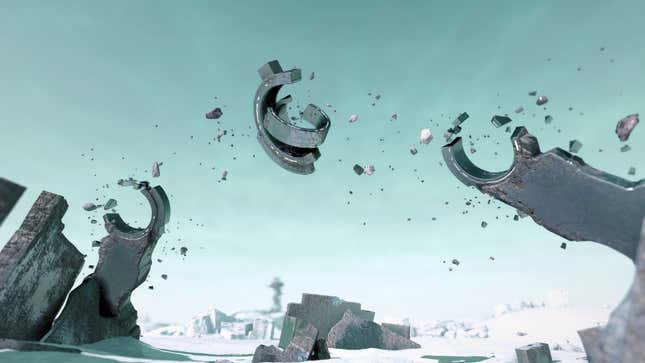
Chasing the mystery at the heart of Starfield
You start off as a miner on a distant world who uncovers a strange object which, upon contact, gives you intense, incomprehensible visions. Soon after, you find yourself being recruited by a group of space explorers known as Constellation, joining up with them to seek out other artifacts like the one you found. This endeavor is at the heart of Starfield’s main story.
Along the way, you’ll encounter tons of opportunities to engage in other quests, work for other factions, pick up odd jobs, and engage in a bit of freelance exploration of your own.
But it’s that main story, which sends you around the galaxy as you hunt down the remainder of the vision-inducing artifacts, which bears Starfield’s strongest narrative offering. In fact, it’s the most memorable main quest I’ve played in a Bethesda game in some time (though to be fair, in some Bethesda games, it’s the side quests that are the real stars of the show). There are mysteries at play in Starfield which are never spelled out, and that preserves a sense of wonder. When the big, concrete revelations do come, they offer satisfying answers without depriving the cosmos of its awe-inspiring mystique. And instead of just spouting exposition at you for completing the quest, Starfield packages its sci-fi elements into a neat game mechanic at the conclusion, one that I’ll hold off on spoiling in this review.
’It’s so sad to see the wealth of our planet fade away’
Starfield establishes early on that humanity spread across the galaxy because we had no other choice: Earth lost its atmosphere and became completely uninhabitable. The game is set 150 years after that cataclysmic event and portrays a world in which corporations own entire planets, humans are still fighting in wars with one another, and the most unfortunate members of society must now contend with living in the most inhospitable places humanity has ever known.
The journeys you undertake on the main quest give you a bird’s eye perspective on the state of humanity across the cosmos, and it’s a complicated one, more pessimistic than I expected. Intentionally or not, Starfield largely suggests that losing Earth wouldn’t be enough for us as a species to overcome greed and the perpetuation of harm and suffering upon each other. To me, it suggests that pioneer-minded discovery is perhaps a distraction from addressing real systemic issues in our world. Or, in the case of Starfield, worlds.
There’s real thematic potential lingering in Starfield, but unfortunately, despite providing fodder for these kinds of thoughts and perspectives, the game frequently fails to rise above mere potential and make the most of the ideas it’s working with. Its environmentalist critique of industrial society feels like a footnote. Still, I don’t walk away from Starfield with just mindless excitement over video games and epic space-faring science fiction. No, I’m hit with grief over climate change and fear over how humans treat one another. The lyrics to Gojira’s “A Sight to Behold” in particular have been stuck in my head ever since playing this game, and not just the references to climate change and war, but also that of a “lust for comfort” and how “entertainment becomes an obsession” amidst a dying planet and warring nations.
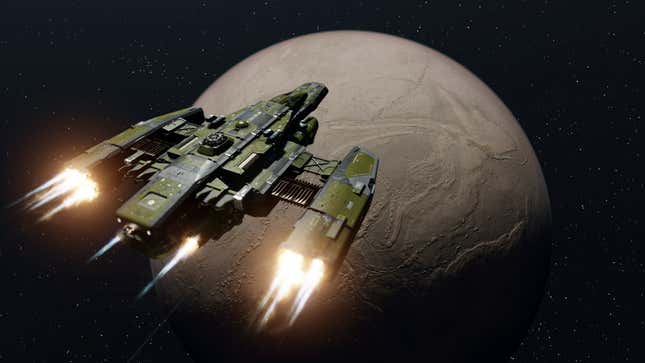
But these themes hardly have a thrilling new vision of the future to support them. No, for all its scale, Starfield’s narrative essence is woefully plain. Where Fallout has its own distinctive, anachronistic charm and The Elder Scrolls has a diversity of landscapes, cultures, architecture, and traditions to give its world character, Starfield is a galaxy in search of an identity. Its “lore” feels like a few different science fiction franchises smushed together and then boiled down to a narrative substrate, the hollow outline of something much more interesting than what you ever see in the actual game. Clearly, it draws more on the “grounded” sci-fi of material like Star Trek and The Expanse than it does the high space fantasy of Star Wars and Destiny, which isn’t inherently bad, of course. However, it does so in a way that emphasizes their utilitarian view of the future while largely overlooking the elements that make them compelling. Just a dash of space opera fun could have gone a long way in livening up the game’s tone.
And yet, in spite of itself, Starfield does feel rather special. It amounts to something more than the sum of its parts. I’ve dismissed many games for having the same issues you can’t escape in Starfield, yet here I am, still playing this one, still thinking about it constantly.
Starfield: An RPG that won’t stop being a shooter
Starfield was marketed as a role-playing game and comes from a studio known for them, but it relies so much on first-person shooter combat that I feel less inclined to compare it to other sci-fi RPGs and space exploration games like Mass Effect and No Man’s Sky than I do to shooters like Borderlands or Destiny.
The central role of guns and shooting was a painful lesson for me early on in Starfield, especially with all of the different ammo types you need to keep track of. Over time you can get the hang of it, relying on dedicated weapons and spotting which ammo types you need to stuff into your inventory. That said, very few pivotal moments in the game give you any other option besides grabbing a gun and going bang-bang-bang. Combat’s long been a core part of Bethesda’s narrative RPGs, but this one wants you to resort to slaughter more than ever. Thankfully, Starfield also has the most refined combat in a Bethesda game yet. This is a solid improvement over Fallout 4’s gunplay, though it still feels a little bit behind a dedicated shooter like Call of Duty or Halo.
Read More: My Pacifist Starfield Run Isn’t Going Great
Buy Starfield: Amazon | Best Buy | GameStop
The shooting mechanics do feel great (that is unless a bug prevents you from shooting—yes, that can happen). But unfortunately for a game that so often wants you to be shooting things, the spaces in which you engage in combat don’t compare to those in most shooters, nor does the AI particularly impress with tactical decisions or meaningfully varied enemy types. Get a good enough weapon and you can absentmindedly mow folks down. But Starfield can still be fun to play as a shooter, especially when you consider the presence of jet packs, low gravity environments, and a unique arsenal of techniques that bend reality a bit. On rare occasions I’ve even felt like a Destiny Guardian, as if Starfield were the single-player Destiny I’ve always wanted. The shallowness of the AI, however, and the lack of the kind of fluidity you find in the best shooters, means that the gunplay loses its luster before too long. It can be thrilling in bursts, but you’ll soon desire other activities in this galaxy.
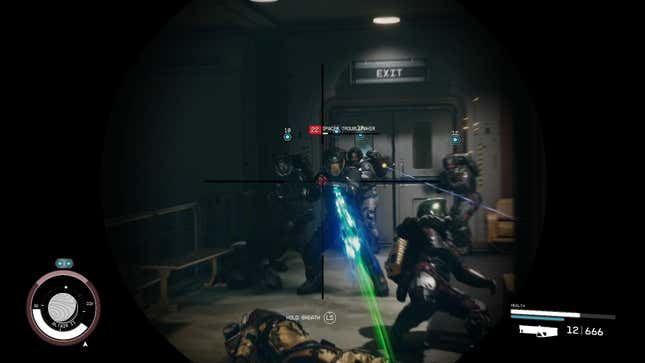
The same is true of ship combat. In bursts, it’s fun (especially if Barrett, one of your potential companions, is on board to lend his personality to moments of victory and defeat), but like those you experience on foot with a gun in hand, Starfield’s ship-based shootouts feel like they take place in too limiting of an environment, with AI that’s only a substantial challenge if you’ve failed to level up your ship’s combat abilities through upgrades and skills.
While you’ll spend much of Starfield looking down the barrel of a gun, you also have access to RPG skills such as stealth, improved space travel, and persuasion abilities, but they’re gated behind a skill tree which you progress through at a snail’s pace. Crafting and outpost building in particular demand that you overcome an uphill battle of meeting constant prerequisites before things get interesting. Despite a bevy of unlockable skills across categories like Social, Tech, and Science, the lack of interesting quest design means that shooting crap is by and large what you do.
The scale of Skyrim and beyond, cut up into tiny little repetitive pieces
The best open-world games make you feel like you’re in a believable place with a satisfying sense of scale. These worlds shatter the concept of “levels” in a video game and provide you with a singularly large space for you to inhabit, explore, save, or perhaps conquer. Executed well, open-world games like Fallout 4 or Skyrim sell the illusion of a non-linear world that exists beyond the life of your character. It’s a space to wander, a space that invites discovery and sight-seeing, with the understanding that you can actually go to that mountain peak or mysterious structure you can see in the distance.
Starfield, however, offers a world that is far too fractured to create this illusion of wholeness and connection. You don’t directly fly to and land on planets like you do in No Man’s Sky. Instead, you chart your course through the cosmos via several layers of menus which don’t always make sense and which reduce the experience of intragalactic travel to one of selecting abstracted dots and icons on a map. And that’s complicated by early learning pains with the UI, which has a variety of different ways for you to “chart” a path, land directly on a planet, or go to a specific place, not to mention various shortcuts that aren’t spelled out, like the ability to go immediately to the star map by holding down the menu button. On mouse and keyboard it’s a bit better, with dedicated keys like L to go straight to your quest log or P to go to your skills. But on a gamepad, navigating the menu requires a bit of memorization before it feels natural—and even once you’ve spent some time with it, it still feels clunky.
Once planetside, there’s a wide variety of different “biomes” to explore, and plenty of random placement of interior spaces, but it’s all segmented from the heart of the game’s quests through loading screens and menus, all so frequent and numerous that they undermine the illusion that this is actually all one cohesive space.
Sure, loading screens exist for towns and buildings in previous Bethesda games and plenty of other games as well. But the best open worlds conjure a persuasive sense of cohesion and freedom in spite of these little breaks. You might spot a place in the distance and indulge your desire to walk somewhere, visiting a place only to satisfy your digital wanderlust. Seeing a town atop a hill go from part of the horizon to a place you’re now standing in is part of the theater of these games.
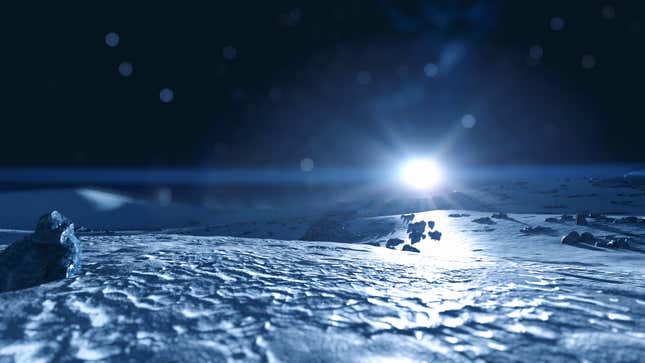
That free-roaming experience is not really here in the same way in Starfield. You may glimpse it from time to time when wandering planets, but the defining settlements—where the important people live, where the history and lore of the world is made—aren’t part of the natural flow of wandering. It’s a dramatic loss.
In Starfield, you select a planet and touch down in a pre-designated area (which prompts a loading screen) or an area you select on the 3D-rendered planetary map. Once you’re on the surface, you can catalog material resources, plant life, animals, and specific planetary “Traits.” There may also be dungeons to plunder, or friendly NPCs who will give you minor quests like “go kill these damn space pirates 700 meters from here.”
You can also build outposts on these planets, though games like Fallout 4 have offered more freedom of design and aesthetic expression in their similar systems. Instead, Starfield’s outposts serve a more utilitarian purpose, providing dedicated spaces to mine for and store natural resources for crafting, commerce, and leveling up. Some may find satisfying mechanical depth in all this, while others are likely to bemoan the laborious monotony it can elicit.
Personally, I’m digging outpost building. I expect that many who loved Fallout 4’s settlements won’t find as much joy here, but maintaining and establishing outposts is proving to be a really satisfying management game that encourages me to explore this universe and map out cargo supply routes across the galaxy. I recently spun up a new character to ignore as many quests as I can and simply live life managing outposts, and I’m excited about moving through the game this way.
Outposts, along with ship building, allow for a nice amount of customization and a feeling that you’re playing an active role in creating a unique space of your own. Ship building could stand to allow more customization of its interior spaces, however. You don’t have much control over what’s inside your ship, and making serious changes in the ship builder can result in all those mugs, plushies, Newton’s cradles, and other knick-knacks you’ve collected and placed around your cabin getting tossed into your ship’s inventory, wrecking all progress made decorating the space.
You can engage in these ambient planetside activities of violence, exploration, sightseeing, and outpost management to your heart’s content. It’s kind of like a space-themed zen garden kit you can just mindlessly sift through. It can be rather soothing, if I’m being honest.
Read More: Starfield Is So Chill I Keep Falling Asleep
Buy Starfield: Amazon | Best Buy | GameStop
On specific worlds, however, there are dedicated towns, but only a few. There’s the city of New Atlantis on Jemison, the underground town of Cydonia on Mars, Akila City on Akila, Neon on Volii Alpha, and a few others. Like so much of Starfield, every major settlement is gated behind at least two or three menu and loading screens. Where locations in the best open-world games feel like places that permanently exist and are situated within a living world, Starfield’s galaxy feels like a file structure in my computer’s operating system.
Read More: Starfield’s Local Planet Map Is Horrible
That said, planetary environments can be simply gorgeous to walk around in. And the procedurally generated natural spaces you explore often feel dynamic enough that, while you’ll spot some similarities here and there, most worlds you touch down on feel distinct. Navigating the terrain is slow (there are no vehicles, just a jet pack which kinda sorta helps), but I find it rewarding. I’ve spent the equivalent of nearly six days straight in this game, putting me at right around 150 hours of total playtime, and most of that has been spent blissfully soaking in and wandering about these planets. And I don’t intend on stopping.
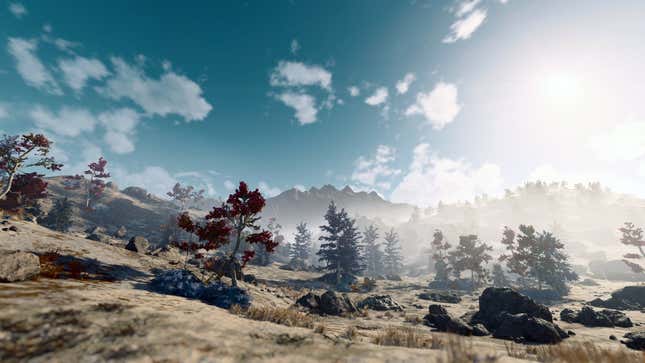
Taking in the sights of an epic mountain, or coming across the top of a hill to see the rings of Saturn fill the night sky, hasn’t gotten old. I get pleasantly lost in these environments very easily, enjoying the space, the walk, the calm. Just as I love listening to a work of ambient music that stems from a musical process just flowing through a modular synth patch, so too do I enjoy the gentle emergence of mountainscapes, forests, looming planets, and gorgeous starry skies. I just wish I could come across towns and major settlements in the same organic way.
Read More: Starfield’s Photo Mode Is Deeply Satisfying
Interior environments of the kind you’ll randomly explore, however, are dramatically repetitive. Far too often, that “abandoned mining facility” you decide to check out looks identical to one you just came from in another star system. Why there’s seemingly no procedural generation at work for interior environments, or at least more variations of these pre-fabricated spaces, is just jarringly weird. It dramatically threatens the feeling of exploration when you see the same broken catwalk in the same mining facility every time.
The same is true for certain planetary “Traits,” distinct natural occurrences like the remnants of a glacier, a crystal formation, or a meteor crater. These repeat so often during planetary exploration that it breaks the illusion that you’re exploring a natural place. On many worlds, you’ll need to scan these features in order to completely survey a planet (you can then sell the survey data to vendors). So coming across the same melted glacier, covered crater, or swampy puddle gets old quick.
Granted, it might be reasonable to expect reused assets to crop up here and there across 1,000 planets, but it was Bethesda’s choice to fill this game with so many planets in the first place. And there’s not even an effort to make it appear like these are generic prefabs that this society is using, not when boxes, vehicles, medpacks, and lockers are all placed in the exact same place, every time; a smaller overall scale would’ve made this repetition feel less notable for sure.
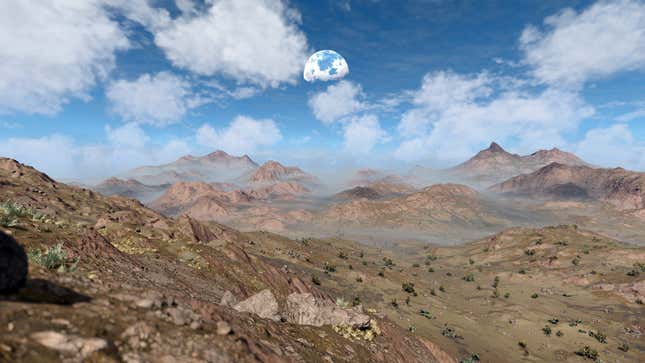
So, Starfield’s exploration bogs you down in layers of unintuitive menus and sends you down the halls of blatantly repetitive interior spaces, yet there remains a deep satisfaction to be had in charting out these worlds, immersing yourself in the pleasure of just digitally existing somewhere as you take in beautiful cosmic sights. What happens, though, when you tire of sightseeing? What if you’re looking for some thrilling heroics?
Unfortunately, Starfield’s quests leave much—much—to be desired, with gameplay that just brutally disappoints.
A deeply uninteresting world on a galactic scale
In addition to its main quest line, Starfield features four faction quest lines of varying mission length, four companion quest lines, and dozens and dozens of random things you’ll find needing done around its worlds. That’s in addition to the more rote “go kill these pirates” quests you may pick up from random NPCs or from mission boards found throughout the galaxy.
With the exception of the final arc of the main story (and maybe bits of the UC faction quest), I pursued almost none of these quests for their narrative intrigue, and found virtually nothing interesting to do in them. Starfield’s environments may border on photorealism, but its character dialogue and narrative premises are a puppet show of trite conversations and meager offerings to the player. I didn’t feel a need to act in this world for any genuine reason. I was merely checking things off a list, and by goddess do the NPCs of this world have lists and tasks and meaningless busywork for you to do. It almost makes you wonder how anything ever gets done here.
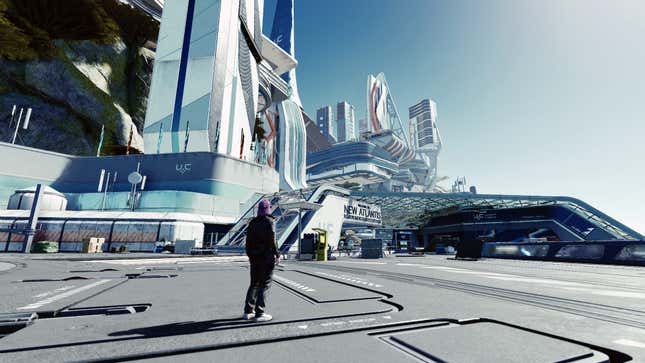
But though you’re clearly the center of the damn universe with the way everyone spills their life story to you at the drop of a hat, there’s a dramatically impoverished level of player choice in Starfield. Granted, I didn’t come here expecting an immersive sim, but when literally stealing a plot object always alerts the entire ship personnel and nets me a bounty regardless of how many points I invested in stealth and the fact that no one saw me touch it, I’m deprived of an opportunity to roleplay my character in my own way. And in that case, just what the hell was stealth for this entire time?
When my options as someone investigating crimes across the galaxy are to either kill the person responsible or let them continue to get away with it by paying me off, with no room in the middle for anything else, the quest feels like playing a game of Dungeons & Dragons with the most railroad-y DM imaginable. And I can’t even go back to the person in charge of my quest to talk to them about the difficult situation before being given the forced decision to take a deeply unethical bribe or, um, bludgeon someone to death with a rescue ax.
This lack of choice and interesting outcomes is at the heart of Starfield’s failure to ever provide interesting challenges beyond pointing and shooting. At one point during the game’s many “go play space cop” quests, I wanted to find a non-violent solution with an antagonist. I used my maxed-out Persuasion skill to make them stop attacking me and then approached them for a conversation. The game simply cycled me through the exact same conversation I’d just had with them before the fight with the exact same outcome as before. Starfield is largely on rails, with occasional choices at the points of departure.
And even when you want to pull a Trevor Philips because those suits at Paradiso unleash your inner murder space cadet, so many characters have invincible plot armor that it makes the game feel like a theme park, with the main attractions gated off and unalterable.
There could be room to excuse this if I were talking about bottom-of-the-barrel quests tucked away somewhere in a random location. But the poverty of choice and interesting outcomes from main feature questlines makes for a dramatically shallow experience at the very heart of Starfield’s narrative moments.
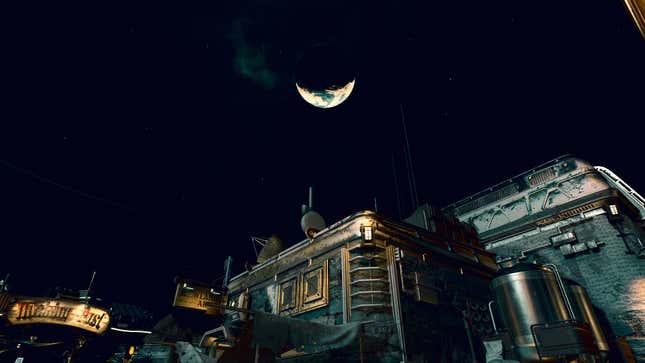
All of this is to say nothing of the frequent bugs that make this predominantly milquetoast gaming experience tip over into frustration. You name it, I’ve experienced it: Quests that will never ever complete despite my doing everything I’m supposed to do; a ship that constantly makes clicking sounds no matter how many times I repair it; my ship landing inside of a planet; my ship landing inside a perpetual state of blinding light; my companion Sam Coe’s daughter never coming aboard my ship despite him constantly referring to her as being there (that’s a fun one to headcanon); and there are still two damn scientists stuck in my ship for some reason who, upon seeing me, say “I really hope I get to see my family again” every single time.
Starfield can be boring, and it can be a total mess. And yet in spite of all that, I can’t stop thinking about it.
Starfield dramatically falls short in its attempts to be so many games at once. Its world is segmented and lifeless, with a frustrating learning curve before seamless navigation ever feels possible. Its various skills brush up against rigid quest structures, denying you the freedom to use them in clever ways. Yet it features beautiful visuals which you can peacefully take in, making you feel grounded in its spectacular galaxy, and does satisfy that itch of just rummaging through crap and collecting things. There is a joy to be had in just checking things off lists and going through the motions of this kind of Bethesda game. And Starfield is capable of inspiring some deep and complicated thoughts and emotions, its vastness and narrative, for all its flaws, hinting at haunting meanings about our species and the path we’re on.
In Starfield, many might see a time-tested, signature charm. Others might see a time-worn, laborious monotony. These are fair perspectives. A game this large is hard to distill into one set of strengths or one set of weaknesses. As in other Bethesda games before it, you’ll likely have to make your own fun here, but in giving us not just a swath of post-apocalyptic terrain or a fantasy realm but an entire galaxy to explore this time, Starfield makes all the flaws and shortcomings of its patchwork world all the more glaring.
Buy Starfield: Amazon | Best Buy | GameStop
.
